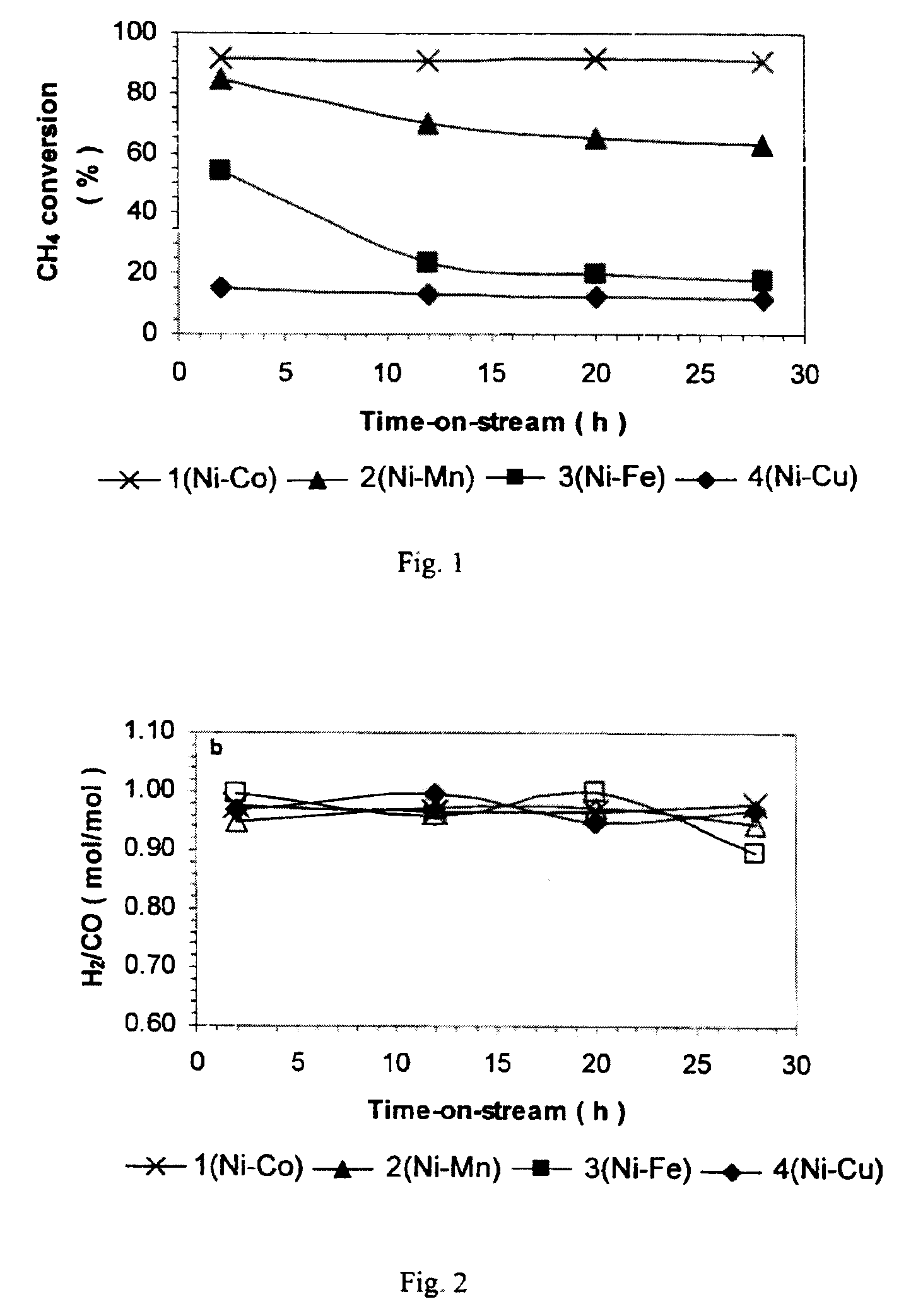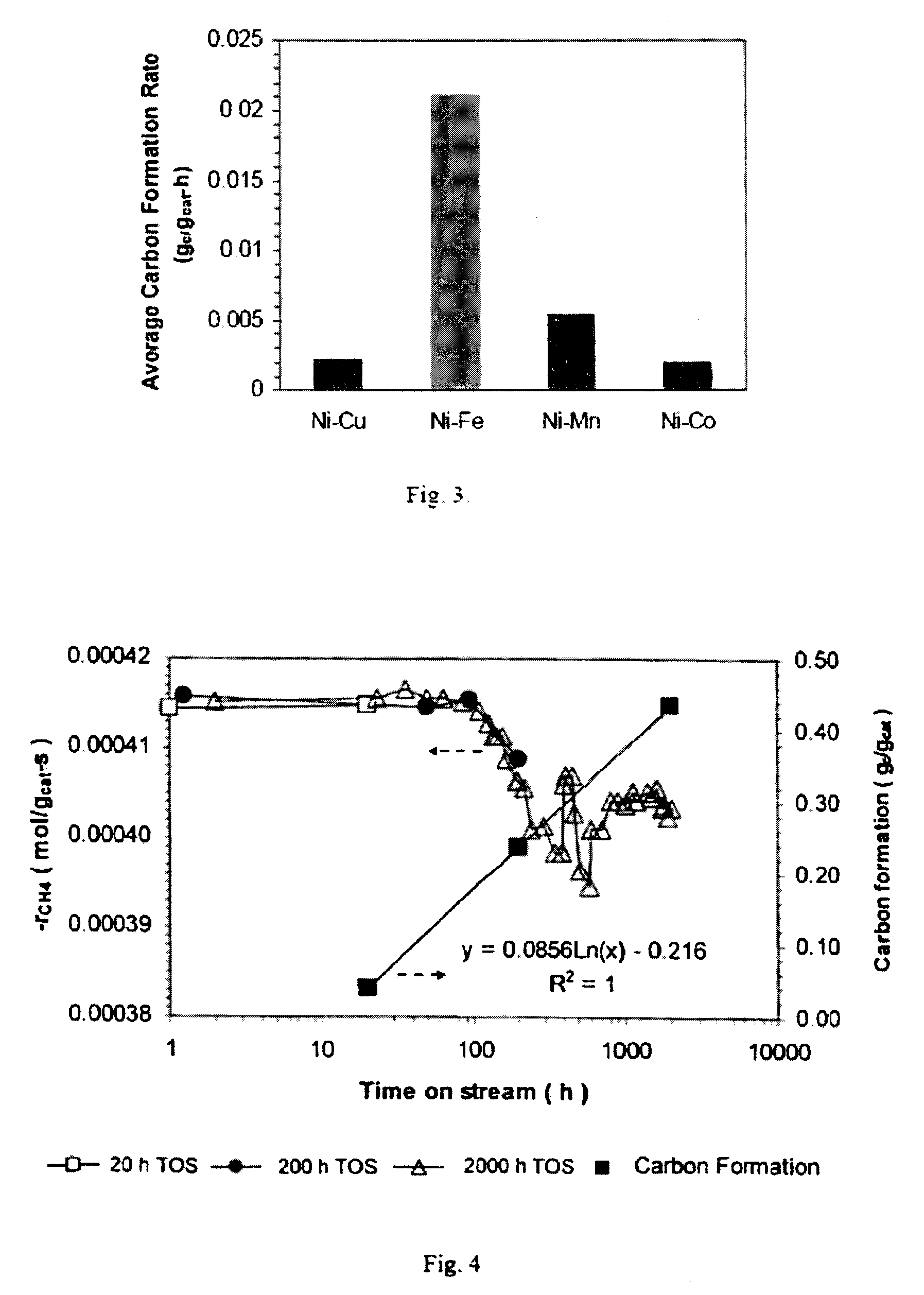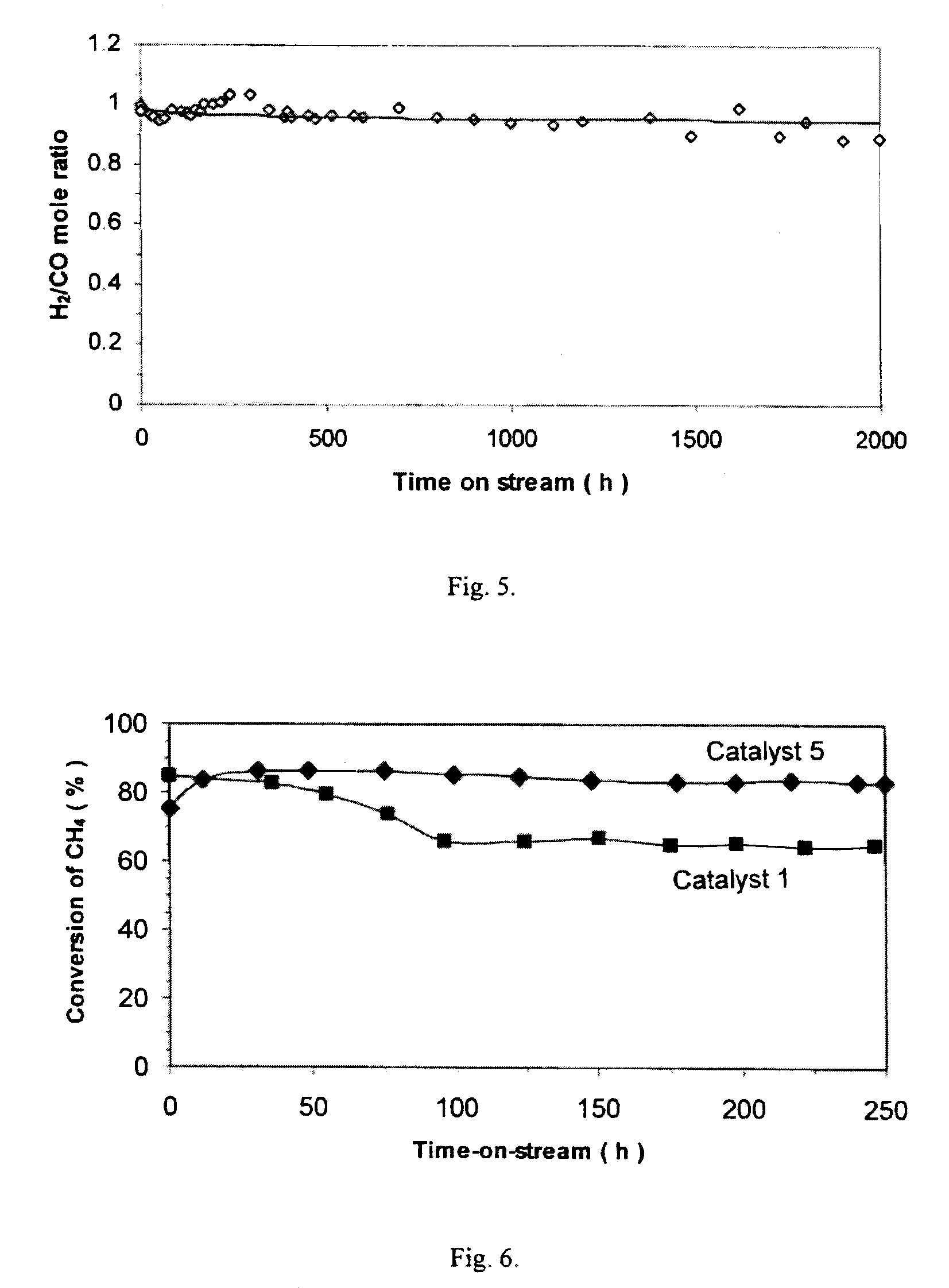Catalyst for production of synthesis gas
a catalyst and synthesis gas technology, applied in the direction of catalyst activation/preparation, metal/metal-oxide/metal-hydroxide catalyst, chemical production, etc., can solve the problems of low selectivity for target products, high cost of known catalysts, and severe and rapid deactivation
- Summary
- Abstract
- Description
- Claims
- Application Information
AI Technical Summary
Problems solved by technology
Method used
Image
Examples
example 1
Catalyst Preparation, Characterization and Testing
[0067]The catalysts described in Examples 2-7 were prepared, characterized and tested according to the procedures described in this Example 1 below.
[0068]Catalyst Preparation
[0069]Bimetallic catalysts having an Al—Mg—O framework were prepared by co-precipitating a common aqueous solution of nickel nitrate (98% purity, Lancaster Synthesis Inc.), cobalt nitrate (99% purity, Aldrich Chemical Company), magnesium nitrate (EMD Chemicals Inc.) and aluminium nitrate (EMD Chemicals Inc.). Other bimetallic catalysts were prepared by replacing cobalt nitrate with iron (III) nitrate (99% purity, Lancaster Synthesis Inc.), manganese nitrate (99.98% purity, Lancaster Synthesis Inc.), or copper (II) nitrate (99% purity, Aldrich Chemical Company). Yet other bimetallic catalysts were prepared by replacing nickel nitrate with manganese nitrate. Monometallic catalysts were prepared by coprecipitating a common aqueous solution of either nickel nitrate o...
example 2
28 h Test of Catalysts 1-4
[0084]Bimetallic catalysts containing Ni and one of Co, Mn, Fe and Cu were prepared by coprecipitation and designated Catalysts 1-4 respectively. Bulk metal composition, BET surface area, pore volume and average pore diameter are shown in Table 1. Catalysts 2-4 (Ni—Mn, Ni—Fe and Ni—Cu) had similar levels of BET surface area at 14-18 m2 / g, while Catalyst 1 (Ni—Co) had a significantly higher BET surface area at 53.5 m2 / g. Pore volume followed the order Ni—Co>>Ni—Cu>Ni—Mn>Ni—Fe while the average pore diameter followed the order Ni—Co<Ni—Fe<Ni—Mn<Ni—Cu.
TABLE 1Bulk metal composition, BET surface area, pore volume and average porediameter of Catalysts 1-4BETAverageBulk Metal CompositionsurfacePorepore(mol %)areavolumediameterNo.CatalystNiCoMnFeCuAlMg(m2 / g)(mL / g)(nm)1Ni—Co6.19.3———28.256.453.50.16010.42Ni—Mn6.0—9.0——27.857.117.20.07316.93Ni—Fe6.5——7.9—29.056.617.80.05612.04Ni—Cu6.8———6.928.657.714.70.08819.6
[0085]To screen different bimetallic combinations, activi...
example 3
20, 200 and 2000 h Tests of Catalyst 1
[0087]To investigate stability and carbon deposition over a longer term, Catalyst 1 (Ni—Co) was tested for 20, 200 and 2000 h, respectively. Again, samples were prepared by diluting 0.05 g of catalyst with 0.450 g quartz sand. Tests were run at 750° C., 1 atm, F=5.5 L / h, and CH4 / CO2 / N2=1 / 1 / 1. CH4 conversion rates and carbon deposition are shown in FIG. 4.
[0088]In the 20-h test, the CH4 conversion rate was maintained at about 0.000415 mol / gcat-s, but the amount of carbon deposited was 0.0408 gc / gcat. In the 200-h test, the CH4 conversion rate was maintained at about 0.000416 mol / gcat-s for 100 h but dropped to 0.000409 mol / gcat-s at 200 h. Over the 200-h test, 0.2374 gc / gcat was formed. In the 2000-h test, the CH4 conversion rate again began to drop at 100 h from the initial 0.000415 to 0.000398 mol / gcat-s at about 300 h, fluctuated between 0.000395 and 0.000407 mol / gcat-s until 700 h, and stayed stable at 0.000404 mol / gcat-s for the last 1300 h....
PUM
| Property | Measurement | Unit |
|---|---|---|
| Temperature | aaaaa | aaaaa |
| Temperature | aaaaa | aaaaa |
| Temperature | aaaaa | aaaaa |
Abstract
Description
Claims
Application Information
 Login to View More
Login to View More - R&D
- Intellectual Property
- Life Sciences
- Materials
- Tech Scout
- Unparalleled Data Quality
- Higher Quality Content
- 60% Fewer Hallucinations
Browse by: Latest US Patents, China's latest patents, Technical Efficacy Thesaurus, Application Domain, Technology Topic, Popular Technical Reports.
© 2025 PatSnap. All rights reserved.Legal|Privacy policy|Modern Slavery Act Transparency Statement|Sitemap|About US| Contact US: help@patsnap.com



